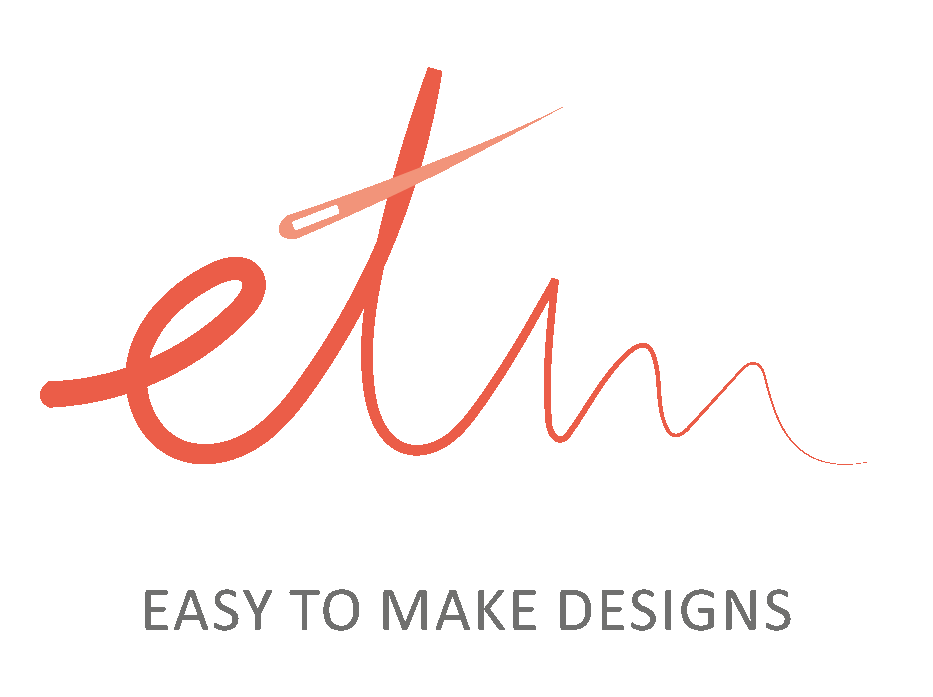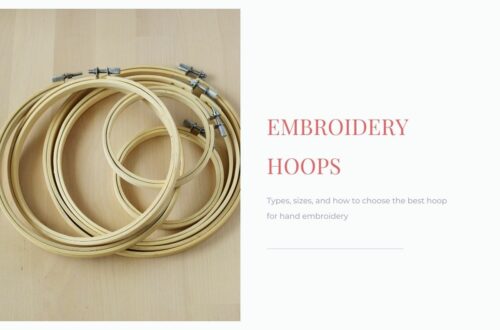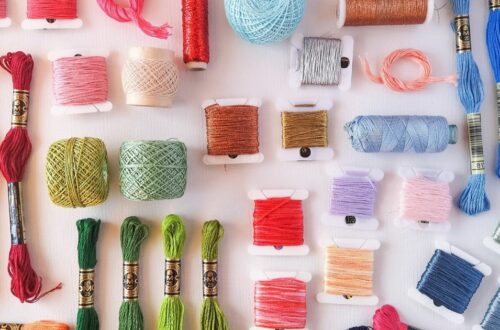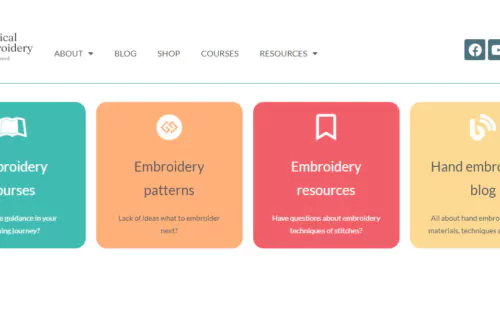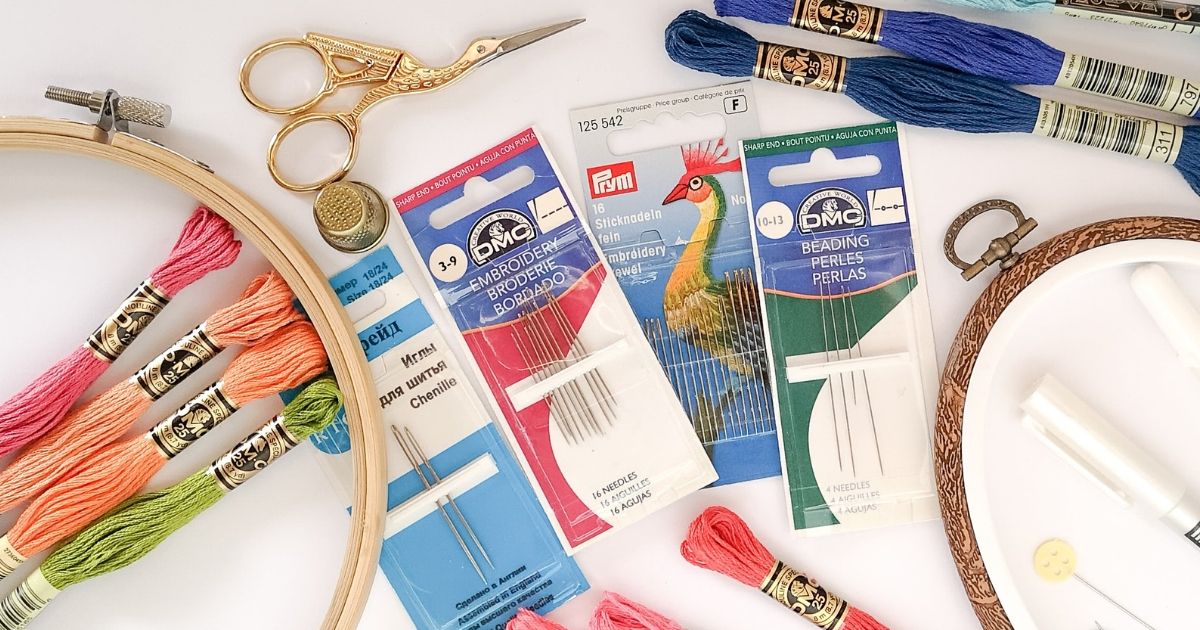
Everything you need to know about hand embroidery needles
In this article, I cover everything you need to know about hand embroidery needles. For the person who has never embroidered or sewn by hand, it may look like all the needles are the same – just a very fine slender piece of polished metal with a point at one end and a hole or eye for thread at the other. But it’s just a first impression. Different types of needles serve a different purpose. Also, the needles vary in size.
Why is it important to know the tools and materials in embroidery?
Choosing the right tools will make your hand embroidery experience more pleasant and easy. Some time ago I’ve struggled with bullion knots and french knots, and it all was happening just because of the wrong choice of the needle. After I’ve changed the needle, the process became fluid and the results – much better. When I wanted to embellish my hand embroidery with beads and sequins, I had another problem – the beads were too small for every needle I had. Again, the problem was solved with the help of the right needle.
Types of needles
There are many different types of needles and there are many ways to use them, but in this blog post, I will talk only about the needles that I use in hand embroidery and will mention only the main characteristics and most common ways to use them.
Crewel needles (also called embroidery needles)
- Sharp point
- Medium length
- Shaft slightly thinner than the eye
- Used for: general surface embroidery, crewel work, goldwork, whitework, and practically any embroidery technique that requires a sharp needle.
Tapestry Needles (cross stitch needles)
- Blunt, rounded point
- Medium length
- Long eye, shaft slightly thinner than the eye
- Used for: canvas work, cross-stitch. Also, this needle is very useful for whipped and laced stitches because a blunt tip helps to avoid snagging the main stitches.
Chenille Needle
- Very sharp point
- Large eye, shaft lightly thinner than the eye
- Used for: thicker or multi-stranded threads, braids, metallics, chenille thread. Used in crewel embroidery, ribbon embroidery.
Milliner Needle (Straw Needle)
- Sharp point
- Long and fine
- Has a round eye that is not wider than the needle shaft
- Used for: appliqué, bullion knots, cast-on stitch, and french knots. Because of the longer shaft and the eye of the same size as a shaft, this needle makes it easier to wrap the thread around the needle many times and pass it through the wrapped threads.
Beading Needle
- Sharp point
- Long, very fine shaft
- Long, narrow eye
- Used for: working beads, cords, pearls and sequins
Needle sizes
Crewel needles come in sizes 1 – 12, with 1 being the largest and 12 being the finest.
Tapestry needles come in sizes 13 – 28, with 13 being the largest and 28 being the finest.
Chenille needles come in sizes 13 – 28, just like tapestry needles.
Milliner Needles come in sizes 1-10, with 1 being larger and 10 being finer.
Beading Needles come in sizes from 10 (thicker) through 15 (thinnest).
What size of the needle do you need?
When you choose a needle for your next project, consider:
- How thick is the thread you are going to use? The shaft of the needle should be about as thick as the embroidery thread. If you use a standard 6 stranded embroidery floss, a needle size will depend on how many strands of the floss will you use. For 6 strands I would recommend using needle size 5, for 3-4 strands – No. 7, for 2-3 strands No.8 and for a single-strand – No. 9. Your choice will also depend on the fabric you will choose to embroider on.
- How thick is a weave of the fabric? There should be no real resistance in the fabric when pulling the eye of the needle through. If it’s hard to get the needle through, you should choose a larger needle. The hole the needle makes should be large enough for the thread to pass through, but not any larger.
- What stitches are you going to use? If you do canvas work, cross-stitch embroidery or some whipping or lacing – Tapestry needles are your choice. For bullion knots, french knots or cast-on stitches – choose Milliner needles.
- What materials are you going to use? If you are using thick wool or ribbon for embroidery, choose Chenille needles. For the bead embroidery – choose beading needles.
Taking care and keeping track of your needles
Whatever type of needles will you choose, remember to take good care of your needles. It is important that they are straight and have undamaged tips. They should slide effortlessly through the fabric, not pull at it or tear it. If the needle is corroded, bent or is not sharp anymore, change it with a new one.
There are many solutions on how to keep your needles in order.
- Keep your needles in the needlebook. It is a small textile book made from felt of other fabrics with pages where you can keep your needles, pins and other essential embroidery tools like scissors and thimble.
- Use a pincushion. It is a small, stuffed cushion, typically 3–5 cm across, which is used to store pins or needles with their heads protruding to take hold of them easily, collect them, and keep them organized. Pincushions are typically filled with ground walnut shells or steel wool to keep your needles sharp.
- Keep your needles in their original package, so you will always know the size and a type of the needle.
If you keep loosing the needles while you embroider or you use more than one needle at a time – consider using a needle minder – a magnetic stitching accessory designed to help prevent your needle from getting lost when you need to take a short break from your stitching or as you are changing threads. They are made from two strong magnets with a decorative top and a plain backing magnet.


